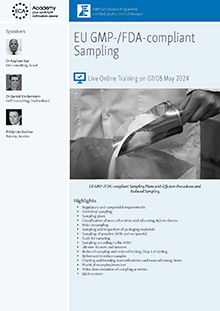Handling of OOS Results in Europe
For some time now, information about the handling of OOS results has been put on the website of the MHRA. There, you can find a Guidance document entitled "Out of Specification Investigations". This document was updated last year to add microbiological aspects.
It is easier to understand than the FDA Guideline on the same topic. The different Flow Charts are also helpful.
A definition of all terms - both Out-of-Specification (OOS) Results and Out of Trend (OOT) Results - is provided at the beginning as well as atypical / aberrant / anomalous results. A definition of the term "Reportable Result" is also provided as follows: "is the final analytical result. This result is appropriately defined in the written approved test method and derived from one full execution of that method, starting from the original sample."
Regarding averaging, it is explicitly said that it "must be specified by the test method". Moreover, the 95% Confidence Limit must be taken into consideration when averaging is used.
Retesting may be performed if no assignable cause can be found to explain a deviating result. Retesting should be performed on the original sample not on a different sample. Regarding the number of retests required, the MHRA refers to other publications suggesting 5, 7 or 9 retests. Retest results shouldn't be averaged with the original results which triggered the OOS investigation.
Like in the FDA Guidance, an outlier test solely can't be considered as sufficient to justify the rejection of data.
Also the aspect of OOS and OOT results for stability testing is addressed.
For quite a long time, Germany has been using the ZLG Aide Mémoire (Zentralstelle der Länder für Gesundheitsschutz bei Arzneimitteln und Medizinprodukten) on the monitoring of manufacturers of medicinal products; section 6.8 also addresses the handling of OOS results. With regard to retesting, the Aide Mémoire defines that the number of retests should be set in advance in an SOP based on sound scientific judgement and should be statistically valid.
The ZLG Aide Mémoire also states that averaging is allowed: the average value must correspond to the specification, but single results must not. However, it is a condition that acceptance criteria should be defined for the variability of the single values and that these provisions are described in an SOP.
You can find more information in the MHRA Guidance Document Out-of-Specification Investigations here as well as in the ZLG Aide Mémoire on the monitoring of manufacturers of medicinal products.
Related GMP News
GMP Conferences by Topics
- General Quality Assurance and GMP Compliance Topics
- Hygiene
- General Microbiology Topics
- Regulatory Affairs
- Development
- General Analytics Topics
- Good Distribution Practice
- Sterile Manufacturing
- Computer Validation
- General Qualification/Validation Topics
- General Engineering Topics
- APIs/Excipients
- GMP Basic Training Courses
- Medical Devices and Combination Products
- Packaging and Packaging Material
- Data Integrity
- Qualified Person (QP)
- GMP Auditing
- Documentation
- Cleaning Validation
- General IT Compliance Topics
- Impurities
- OOS / OOE / OOT
- Material Testing
- Validation of Analytical Methods
- Analytical Instrument Qualification
- Stability Testing
- Microbiological Testing
- Technology
- General Manufacturing Topics
- Solid Dosage Forms/Semi-Solid Dosage Forms
- Biotechnology/Blood/ATMP
- Herbal Drug Products/Cannabis/Radiopharmaceuticals
- Others





